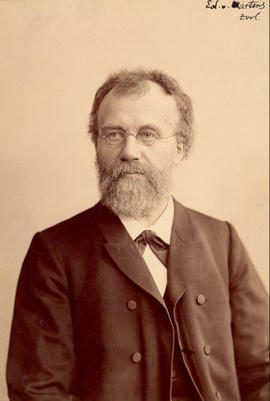Toilet Attendant at ZSL London Zoo
Temporary staff at ZSL London Zoo
Stoker in the Aquarium of ZSL London Zoo
Also known as Carl or Karl Eduard von Martens, he was a German zoologist. He attended university in Tübingen, where he graduated in 1855. He then moved to Berlin, where he would be based for the remainder of his career, both at the Zoological Museum of the Berlin University (from 1855) and, from 1859, at the Museum für Naturkunde. In 1860, he embarked on the Thetis expedition of the Prussian expedition to Eastern Asia. When the expedition returned to Europe in 1862, von Martens continued to travel around Maritime Southeast Asia for 15 months. He published the results of the Thetis expedition in two volumes, constituting the Zoologischer Theil of the "Preussische Expedition nach Ost-Asien." Vol. ii, consisting of 447 pages and 22 plates, contained a very full account of the land molluscs. Back in Berlin, von Martens was curator of the malacological and other invertebrate sections until his death. Von Martens described 155 new genera (150 of them molluscs) and almost 1,800 species (including around 1,680 molluscs, 39 crustaceans and 50 echinoderms.
He was a foreign member of the Linnean Society, and a corresponding member of the Zoological Society of London
Garden Labourer and Propagator at ZSL London Zoo
Zoo Shop Assistant at ZSL London Zoo
